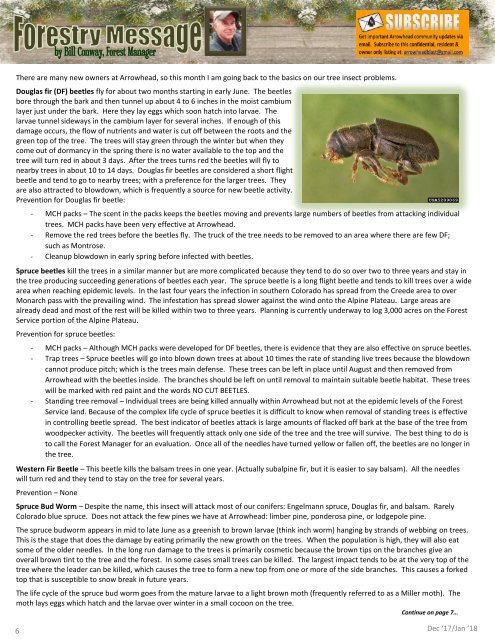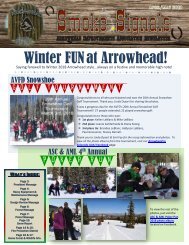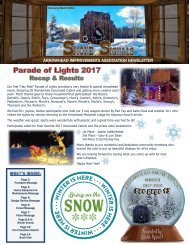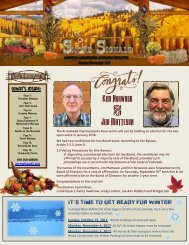AIA Smoke Signals DEC 2017-JAN 2018 Edition
Arrowhead Improvements Association bi-monthly newsletter
Arrowhead Improvements Association bi-monthly newsletter
You also want an ePaper? Increase the reach of your titles
YUMPU automatically turns print PDFs into web optimized ePapers that Google loves.
y Bill Conway, Forest Manager<br />
There are many new owners at Arrowhead, so this month I am going back to the basics on our tree insect problems.<br />
Douglas fir (DF) beetles fly for about two months starting in early June. The beetles<br />
bore through the bark and then tunnel up about 4 to 6 inches in the moist cambium<br />
layer just under the bark. Here they lay eggs which soon hatch into larvae. The<br />
larvae tunnel sideways in the cambium layer for several inches. If enough of this<br />
damage occurs, the flow of nutrients and water is cut off between the roots and the<br />
green top of the tree. The trees will stay green through the winter but when they<br />
come out of dormancy in the spring there is no water available to the top and the<br />
tree will turn red in about 3 days. After the trees turns red the beetles will fly to<br />
nearby trees in about 10 to 14 days. Douglas fir beetles are considered a short flight<br />
beetle and tend to go to nearby trees; with a preference for the larger trees. They<br />
are also attracted to blowdown, which is frequently a source for new beetle activity.<br />
Prevention for Douglas fir beetle:<br />
- MCH packs – The scent in the packs keeps the beetles moving and prevents large numbers of beetles from attacking individual<br />
trees. MCH packs have been very effective at Arrowhead.<br />
- Remove the red trees before the beetles fly. The truck of the tree needs to be removed to an area where there are few DF;<br />
such as Montrose.<br />
- Cleanup blowdown in early spring before infected with beetles.<br />
Spruce beetles kill the trees in a similar manner but are more complicated because they tend to do so over two to three years and stay in<br />
the tree producing succeeding generations of beetles each year. The spruce beetle is a long flight beetle and tends to kill trees over a wide<br />
area when reaching epidemic levels. In the last four years the infection in southern Colorado has spread from the Creede area to over<br />
Monarch pass with the prevailing wind. The infestation has spread slower against the wind onto the Alpine Plateau. Large areas are<br />
already dead and most of the rest will be killed within two to three years. Planning is currently underway to log 3,000 acres on the Forest<br />
Service portion of the Alpine Plateau.<br />
Prevention for spruce beetles:<br />
- MCH packs – Although MCH packs were developed for DF beetles, there is evidence that they are also effective on spruce beetles.<br />
- Trap trees – Spruce beetles will go into blown down trees at about 10 times the rate of standing live trees because the blowdown<br />
cannot produce pitch; which is the trees main defense. These trees can be left in place until August and then removed from<br />
Arrowhead with the beetles inside. The branches should be left on until removal to maintain suitable beetle habitat. These trees<br />
will be marked with red paint and the words NO CUT BEETLES.<br />
- Standing tree removal – Individual trees are being killed annually within Arrowhead but not at the epidemic levels of the Forest<br />
Service land. Because of the complex life cycle of spruce beetles it is difficult to know when removal of standing trees is effective<br />
in controlling beetle spread. The best indicator of beetles attack is large amounts of flacked off bark at the base of the tree from<br />
woodpecker activity. The beetles will frequently attack only one side of the tree and the tree will survive. The best thing to do is<br />
to call the Forest Manager for an evaluation. Once all of the needles have turned yellow or fallen off, the beetles are no longer in<br />
the tree.<br />
Western Fir Beetle – This beetle kills the balsam trees in one year. (Actually subalpine fir, but it is easier to say balsam). All the needles<br />
will turn red and they tend to stay on the tree for several years.<br />
Prevention – None<br />
Spruce Bud Worm – Despite the name, this insect will attack most of our conifers: Engelmann spruce, Douglas fir, and balsam. Rarely<br />
Colorado blue spruce. Does not attack the few pines we have at Arrowhead: limber pine, ponderosa pine, or lodgepole pine.<br />
The spruce budworm appears in mid to late June as a greenish to brown larvae (think inch worm) hanging by strands of webbing on trees.<br />
This is the stage that does the damage by eating primarily the new growth on the trees. When the population is high, they will also eat<br />
some of the older needles. In the long run damage to the trees is primarily cosmetic because the brown tips on the branches give an<br />
overall brown tint to the tree and the forest. In some cases small trees can be killed. The largest impact tends to be at the very top of the<br />
tree where the leader can be killed, which causes the tree to form a new top from one or more of the side branches. This causes a forked<br />
top that is susceptible to snow break in future years.<br />
The life cycle of the spruce bud worm goes from the mature larvae to a light brown moth (frequently referred to as a Miller moth). The<br />
moth lays eggs which hatch and the larvae over winter in a small cocoon on the tree.<br />
Continue on page 7…<br />
6 Dec ‘17/Jan ’18





